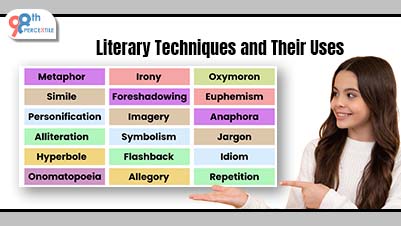Literary techniques, by any other name literary devices, are a set of tools used by writers for embellishing their storylines, arousing emotions, or bringing deeper meanings to light. These techniques help not only as the building blocks of creative writing but also convey the message of novels, poems, and even non-fiction, in ways that would bring people attracted to the narrative and make it memorable. Knowledge and effectiveness in the application of literary techniques can improve any work of writing- fiction, poetry, or even nonfiction. Here's a look at some common literary techniques and their uses.
Download FREE English Worksheets!
Metaphor
A metaphor is defined as a figure of speech that is an implicit comparison of apparently unlike things-saying one thing and meaning another suggesting that they are alike in some important way. With the application of metaphors, people extend their depth of writing since one thing becomes representative of another. Effective use of metaphors can make readers see things differently.
- Example: "Time is a thief" suggests that time steals moments from lives, although he cannot literally commit the related acts of theft.
- Use: A metaphor is used to define an abstract idea with a simple familiar comparison or used to depict lively pictorialness. A metaphor can add life to abstract concepts.
Simile
A simile is like a metaphor. But instead of using them as opposite words or ideas, it makes use of the words like and to perform the comparison. Similes move descriptions a step forward by being more explicit about the comparisons used.
Example: "Her smile was as bright as the sun."
Use: Similes are helpful in evoking mental images and thus explaining things so that abstract ideas take on more concrete realities for readers.
Alliteration
Alliteration is a device used when the consonant sounds of words are near to each other, starting at their beginning. This creates rhythm, which can serve further to deepen the mood or tone of the piece.
- Example: "Peter Piper picked a peck of pickled peppers."
- Use: Alliteration can make the written text sound like music and be therefore more easily remembered. It is used most often in poetry, advertisement, and literature to create a pleasant rhythm and even highlight key phrases.
Irony
This is ironic: an expectation opposed by reality. Verbal irony is when someone says something and means the opposite; situational irony, is where an event occurs that is the opposite of what was expected; dramatic irony, is where the audience knows something, but the characters do not.
- Example: A fire station burns down.
- Use: Irony can be comedic, suspenseful, or emotionally significant in a plot. At times, it may even cause readers to consider the true extent of the events unfolding and, therefore, develop the storyline.
Imagery
Imagery occurs when the language used in a piece of writing stimulates any of the senses of sight, sound, feel, taste, or smell. This helps the audience visualize the scenes and develop a stronger sense of belonging to the plot.
- Example: "The golden sun was filtering through the leaves, spilling a warm glow on the forest floor."
- Use: Imagery makes the reader experience the scenes, characters, and emotions in the writings vividly.
Book a free trial class with 98thPercentile and experience the elite teaching that helps students stay ahead of their regular grade curriculum.
FAQs (Frequently Asked Questions)
Q1. What are literary techniques?
Ans. Literary techniques, or literary devices, are how an author improves his writing, adds depth to the narrative, and engages the reader. Examples include metaphor, simile, and irony.
Q2. What do literary techniques in writing do?
Ans. They add vivid imagery, evoke emotions, and clarify complex ideas, thereby providing engaging yet effective writing.
Q3. Must I use more than one literary technique in one written work?
Ans. Yes, good writers often use more than one technique for depth and complexity in their work.
Q4. What is the difference between simile and metaphor?
Ans. A comparison of two things using "like" or "as" is a simile. A metaphor simply makes a comparison, without using any of those words.
Q5. What is the purpose of foreshadowing in fiction?
Ans. Foreshadowing builds anticipation; it builds suspense and makes the reader ready to know of some things that later in the story will be mentioned, thus keeping them interested.
Book FREE English Trial Classes Now!

 Students/Staff
Students/Staff Parents
Parents ElevatEd
ElevatEd



-Nov-18-2025-03-57-47-3267-AM.png?width=360&length=360&name=401x226%20(6)-Nov-18-2025-03-57-47-3267-AM.png)



-Jul-22-2025-03-16-52-8797-AM.png?width=360&length=360&name=401x226%20(6)-Jul-22-2025-03-16-52-8797-AM.png)






